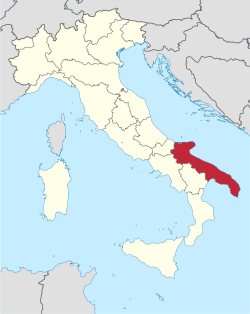
Back Apulië Afrikaans Apulien ALS አፑሊያ Amharic Pulla AN Puilla ANG بولية (إيطاليا) Arabic بوليا ARZ Puglia AST Apuliya Azerbaijani پولیا (ایتالیا) AZB
You can help expand this article with text translated from the corresponding article in Italian. (June 2023) Click [show] for important translation instructions.
|
Apulia
Puglia[a] | |
|---|---|
|
| |
 | |
| Coordinates: 41°N 16°E / 41°N 16°E | |
| Country | Italy |
| Capital | Bari |
| Government | |
| • Body | Regional Council |
| • President | Michele Emiliano (PD) |
| Area | |
• Total | 19,358 km2 (7,474 sq mi) |
| Population (31 December 2016) | |
• Total | 4,063,888 |
| • Density | 210/km2 (540/sq mi) |
| Demonym(s) | English: Apulian Italian: Pugliese |
| GDP | |
| • Total | €77.984 billion (2021) |
| Time zone | UTC+01:00 (CET) |
| • Summer (DST) | UTC+02:00 (CEST) |
| ISO 3166 code | IT-75 |
| HDI (2021) | 0.856[2] very high · 18th of 21 |
| NUTS Region | ITF |
| Website | regione.puglia.it |
Apulia (/əˈpuːliə/ ə-POO-lee-ə), also known by its Italian name Puglia (Italian: [ˈpuʎʎa]),[3][a] is a region of Italy, located in the southern peninsular section of the country, bordering the Adriatic Sea to the east, the Strait of Otranto and Ionian Sea to the southeast and the Gulf of Taranto to the south. The region comprises 19,345 square kilometers (7,469 sq mi), and its population is about four million people. It is bordered by the other Italian regions of Molise to the north, Campania to the west, and Basilicata to the southwest. The regional capital is Bari.
In ancient times, more precisely at the beginning of the first millennium BC, the region of Apulia was inhabited by the Iapygians, while during the 8th century BC its coastal areas were populated by ancient Greeks.[4] Later, the region was conquered by the ancient Romans. It was then conquered by the Byzantines, followed by the Normans, the Aragonese and the Spanish. Subsequently, it became part of the Kingdom of the Two Sicilies, to then be annexed to the unified Kingdom of Italy after the Expedition of the Thousand.
Cite error: There are <ref group=lower-alpha> tags or {{efn}} templates on this page, but the references will not show without a {{reflist|group=lower-alpha}} template or {{notelist}} template (see the help page).
- ^ "Population on 1 January by age, sex and NUTS 2 region", www.ec.europa.eu
- ^ "Sub-national HDI - Area Database - Global Data Lab". hdi.globaldatalab.org. Archived from the original on 23 September 2018. Retrieved 5 March 2023.
- ^ "Puglia travel". Lonely Planet. Retrieved 18 July 2021.
- ^ "Popoli e culture dell'Italia preromana. Gli Iapigi, gli Apuli e i Dauni - Treccani". Treccani (in Italian). Retrieved 25 March 2024.

